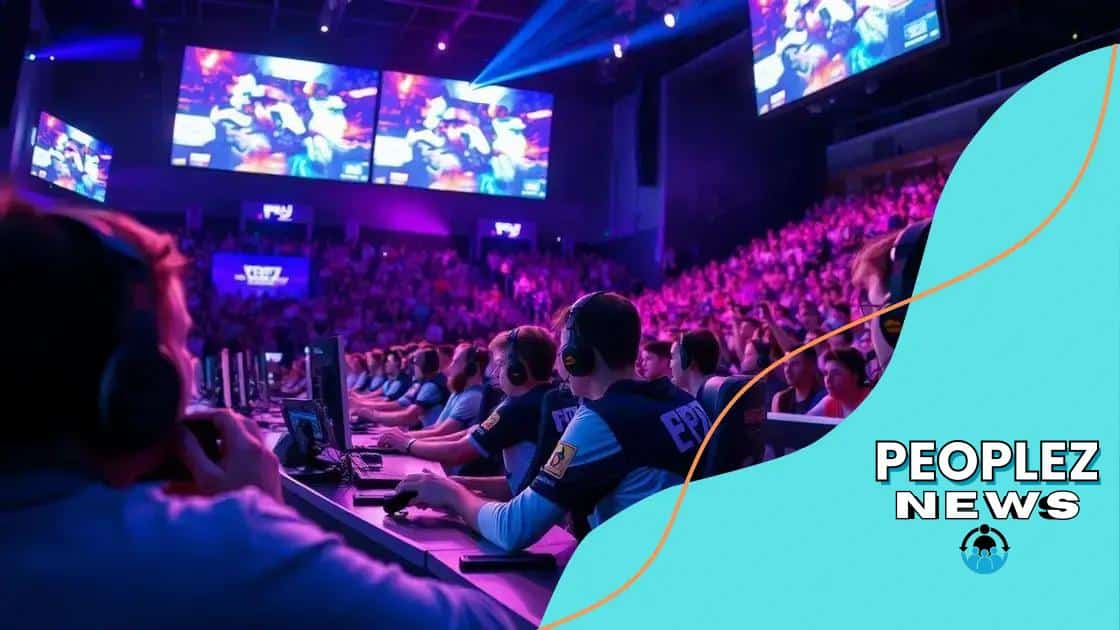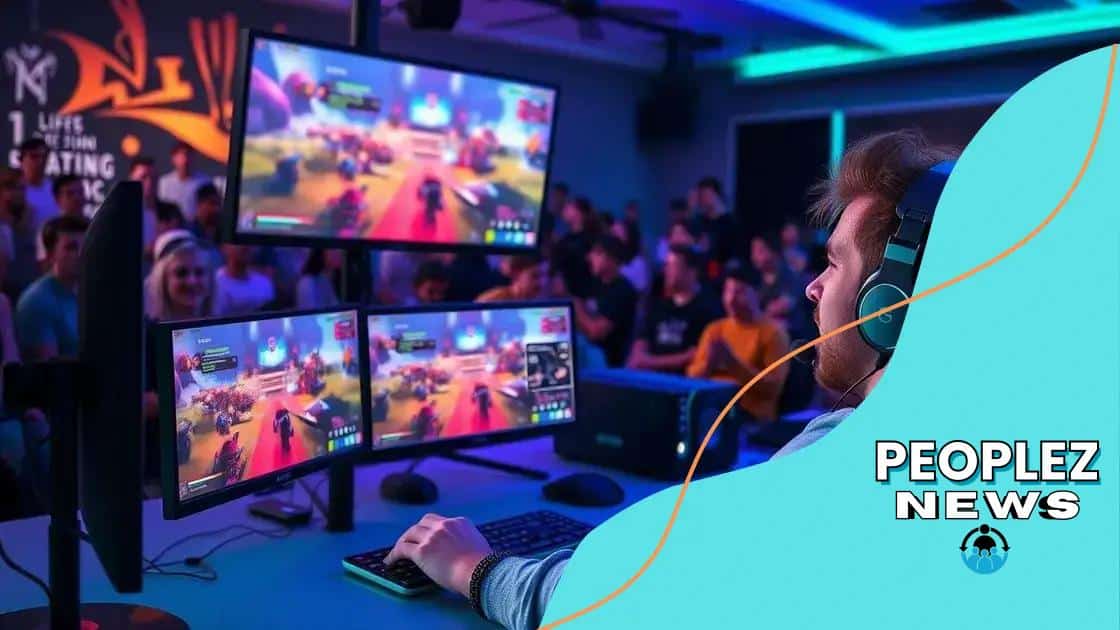How e-sports are influencing mainstream media content

How e-sports are influencing mainstream media content by integrating advanced technologies, enhancing viewer engagement, and creating new collaborative formats, making competitive gaming a vital part of the entertainment landscape.
How e-sports are influencing mainstream media content is a phenomenon that’s capturing attention worldwide. Have you noticed how gaming competitions are becoming mainstream? This shift isn’t just about games; it’s reshaping how we consume media.
The rise of e-sports in popular culture
The rise of e-sports in popular culture has transformed the way we view gaming. Once seen as a niche hobby, e-sports have gained immense popularity and recognition. Today, competitive gaming draws audiences similar to traditional sports, attracting millions of fans around the globe.
One of the significant factors contributing to this rise is the accessibility of e-sports events through streaming platforms. Fans can watch live competitions from the comfort of their homes. This has created a unique culture around gaming, where fans engage not just with the games but with the players and communities involved.
Key Elements of E-Sports Popularity
There are several elements that have fueled the success and integration of e-sports into mainstream media:
- High-Quality Production: Today’s e-sports events are professionally produced, featuring commentary, graphics, and live audiences.
- Celebrity Players: Many professional gamers have become celebrities, drawing in fans who follow their personal stories and gaming skills.
- Major Sponsorships: Big brands and companies have invested heavily in e-sports, recognizing its potential audience and influence.
- Community Engagement: E-sports fosters a sense of community among fans, encouraging interaction and participation.
As e-sports continue to grow, they are attracting traditional media outlets. Competition coverage on television and collaborations with major sports leagues reflect the increasing acceptance of gaming as a legitimate form of entertainment. The surge in e-sports viewership demonstrates changing attitudes towards gaming, making it a key player in today’s entertainment landscape.
E-sports events often fill arenas, similar to traditional sports. Fans flock to watch their favorite teams compete, creating an electric atmosphere. This is further amplified by social media, where highlights and clips go viral, reaching audiences far beyond those in attendance.
How e-sports are changing traditional media coverage
How e-sports are changing traditional media coverage is a fascinating topic that showcases the evolution of media in the digital age. As e-sports gain popularity, they are influencing the way traditional media outlets present coverage of not just gaming, but also sports and entertainment.
One major shift is the way events are broadcasted. Unlike traditional sports, e-sports often utilize platforms like Twitch and YouTube for live streaming. This accessibility allows viewers to engage with content in new ways. Fans can interact with streamers, share their thoughts, and even influence the outcome of games through voting and polls.
Key Changes in Media Coverage
Several key features highlight how e-sports have influenced traditional media:
- Innovative Storytelling: E-sports coverage often includes player backstories and team dynamics, providing deeper narratives that engage viewers.
- Real-Time Interaction: Fans participate actively during broadcasts, with chat features and live social media interactions enhancing the event atmosphere.
- Cross-Promotion: Traditional sports leagues are beginning to incorporate e-sports into their programming, exposing these digital competitions to broader audiences.
- Analysis and Commentary: Similar to traditional sports, e-sports now features expert analysis and commentary, helping viewers understand strategies and gameplay.
The evolution of e-sports coverage not only reflects changes in audience preference but also demonstrates a shift in the media landscape. As e-sports continue to grow, they offer an expanding opportunity for advertisers and sponsors seeking to reach younger demographics.
Furthermore, traditional media entities are increasingly hiring e-sports commentators and analysts to enhance their coverage. This integration bridges the gap between conventional sports and gaming, creating a more inclusive media environment. By adapting to these changes, media outlets can remain relevant and connected to the interests of the audience.
The influence of gaming content on streaming platforms

The influence of gaming content on streaming platforms is significant and growing rapidly. With the rise of platforms like Twitch and YouTube, gaming content has become a dominant force in the entertainment industry. These platforms offer gamers a chance to share their gameplay experiences, connecting with audiences in real-time.
One aspect of this growth is the way gaming content has reshaped viewer habits. Unlike traditional media, where audiences passively consume content, streaming allows for interactive participation. Viewers can engage with streamers through chats, donations, and subscriptions, creating a community around the content.
Key Factors Behind the Popularity
Several factors contribute to the increasing influence of gaming content on streaming platforms:
- Accessibility: With just a few clicks, anyone can access live streams and recorded gameplay from top gamers around the world.
- Diverse Content: Streaming platforms feature a wide variety of gaming genres, appealing to different types of gamers and audiences.
- Engagement: Streamers often interact with their audiences, making viewers feel like part of the experience and fostering loyalty.
- Monetization: Streamers can earn money through subscriptions, sponsorships, and donations, providing incentive for quality content production.
The interaction between gamers and their audiences creates a unique ecosystem. For instance, fans often request specific games or challenges, influencing what streamers play. This dynamic relationship keeps content fresh and engaging, as creators strive to meet viewer preferences.
Furthermore, the influence of gaming content extends beyond just casual gaming. Major tournaments and events are now broadcasted live, attracting millions of viewers. This not only showcases the competitive nature of gaming but also elevates it to a professional level, similar to traditional sports events.
E-sports events: integration with mainstream media
The integration of e-sports events with mainstream media is a significant shift in how we view and participate in competitive gaming. Traditionally considered a niche market, e-sports have now become a prominent part of the media landscape, with events being broadcasted alongside major sports.
One of the most notable changes is how e-sports events are covered on television. Major networks are beginning to air live e-sports tournaments, which brings a whole new audience to these competitions. Viewers can watch their favorite games with professional commentary, just as they would with traditional sports.
The Impact of Media Partnership
Media partnerships have played a crucial role in promoting e-sports. Here are some key aspects:
- Broad Exposure: Streaming platforms collaborate with traditional broadcasters, reaching wider audiences and legitimizing e-sports.
- Increased Sponsorship: As media coverage grows, so does interest from brands keen to sponsor events and teams.
- Enhanced Production Values: E-sports events are now produced with high-quality graphics, analysis, and on-screen statistics, similar to traditional sports broadcasts.
- Better Accessibility: Fans can access live streams, replays, and highlights across various platforms, making it easier to follow their favorite games.
Furthermore, the crossover between gaming and traditional sports continues to expand. Some e-sports leagues are even collaborating with established sports leagues for joint events, attracting even more viewers. This blending of cultures helps normalize gaming in the eyes of mainstream audiences.
As e-sports gain further recognition, they are reshaping how we perceive competition. Events now fill arenas, just like major sporting events, bringing an electric atmosphere. Fans connect not just with the games but also with the players, creating a community that spans continents.
Future trends for e-sports and media collaboration
The future trends for e-sports and media collaboration shape the next evolution of entertainment. As technology advances, so does the way audiences consume content. E-sports are expected to continue merging with mainstream media, leading to innovative formats and experiences.
One emerging trend is the use of augmented reality (AR) and virtual reality (VR) in e-sports broadcasts. These technologies can create immersive experiences, allowing viewers to feel as if they are part of the action. Imagine watching a live tournament where you can change your view of the game or even interact with players in a virtual space.
Innovative Content Formats
As e-sports grow, we are likely to see new content formats that enhance viewer engagement:
- Interactive Viewing: Audiences might be able to choose different camera angles or access players’ perspectives during live matches.
- Cross-media Storytelling: E-sports may collaborate with streaming platforms to create series that follow players and teams over a season.
- Live Events Integration: Major gaming events could be integrated with traditional sports leagues, featuring joint competitions and promotional events.
- Personalized Content: Algorithms will help tailor content to individual viewers, enhancing the relevance of what they see.
As media companies invest more in e-sports, partnerships will likely evolve. Traditional networks may collaborate with game developers to produce high-quality content that attracts larger audiences. This collaboration will involve creating unique programming that highlights the excitement of competitive gaming.
Moreover, with the rise of social media, fans are playing a more active role in shaping e-sports content. Platforms like Twitter and Instagram allow viewers to share their thoughts and influence events in real-time. Content creators are listening to audience feedback and adjusting their approaches accordingly.
In conclusion, the integration of e-sports with mainstream media is transforming how we experience entertainment. As technology advances, we anticipate new formats that will enhance viewer engagement and broaden the audience. With immersive experiences from AR and VR, interactive viewing options, and partnerships between traditional media and gaming, the future of e-sports is bright. This evolution not only reflects changing audience preferences but also signifies a new era for competitive gaming, making it a vital part of cultural and media landscapes.
FAQ – Frequently Asked Questions about E-sports and Media Collaboration
How are e-sports changing traditional media coverage?
E-sports are being broadcasted on major networks, attracting new audiences and promoting competitive gaming as part of mainstream entertainment.
What technologies are enhancing e-sports viewing experiences?
Augmented reality (AR) and virtual reality (VR) are being used to create immersive experiences, making viewers feel part of the action.
How does audience engagement influence e-sports content?
Viewers can interact with streamers and participate in live chats, which encourages a sense of community and influences how content is created.
What future trends can we expect in e-sports and media?
We can expect more interactive formats, personalized content, and partnerships between media companies and gaming studios to evolve.





